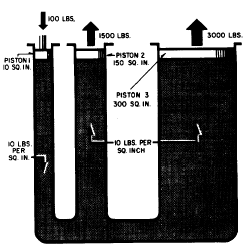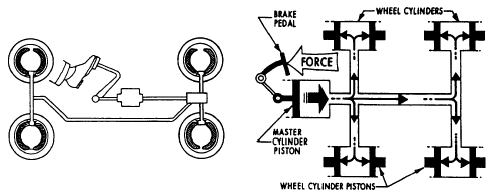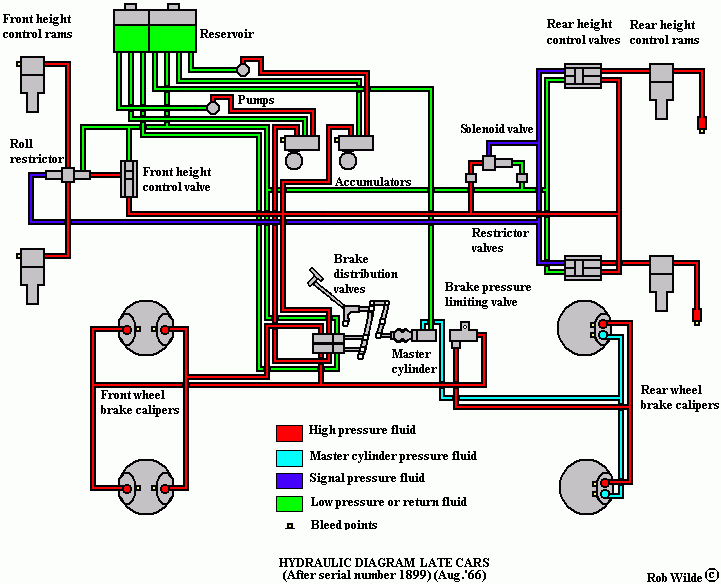
Construction:-
The most common arrangement of hydraulic brakes for passenger vehicles, motorcycles, scooters, and mopeds, consists of the following:Brake pedal or lever
A pushrod (also called an actuating rod)
A master cylinder assembly containing a piston assembly (made up of either one or two pistons, a return spring, a series of gaskets/ O-rings and a fluid reservoir)
Reinforced hydraulic lines
Brake caliper assembly usually consisting of one or two hollow aluminum or chrome-plated steel pistons (called caliper pistons), a set of thermally conductive brake pads and a rotor (also called a brake disc) or drum attached to a axle.
The system is usually filled with a glycol-ether based brake fluid (other fluids may also be used).
At one time, passenger vehicles commonly employed disc brakes on the front wheels and drum brakes on the rear wheels. However, because disc brakes have been shown a better stopping performance and are therefore generally safer and more effective than drum brakes, four-wheel disc brakes have become increasingly popular, replacing drums on all but the most basic vehicles. Many two-wheel vehicles designs, however, continue to employ a drum brake for the rear wheel.
For simplicity, the braking system described hereafter uses the terminology and configuration for a simple disc brake.
System Operation :-
Within a hydraulic brake system, as the brake pedal is pressed/ brake lever is squeezed, a pushrod exerts force on the piston(s) in the master cylinder causing fluid from the brake fluid reservoir to flow into a pressure chamber through a compensating port which results in an increase in the pressure of the entire hydraulic system. This forces fluid through the hydraulic lines toward one or more calipers where it acts upon one or two additional caliper pistons secured by one or more seated O-rings which prevent the escape of any fluid from around the piston.The brake caliper piston(s) then apply force to the brake pads. This causes them to be pushed against the spinning rotor, and the friction between the pads and the rotor causes a braking torque to be generated, slowing the vehicle. Heat generated from this friction is often dissipated through vents and channels in the rotor and through the pads themselves which are made of specialized heat-tolerant materials (kevlar, sintered glass, et al.).
Subsequent release of the brake pedal/ lever allows the spring(s) within the master cylinder assembly to return that assembly's piston(s) back into position. This relieves the hydraulic pressure on the caliper allowing the brake piston in the caliper assembly to slide back into its housing and the brake pads to release the rotor. Unless there is a leak somewhere in the system, at no point does any of the brake fluid enter or leave.
Component specifics :-
(For typical light duty automotive braking systems)
The brake pedal is a simple lever. One end is attached to the framework of the vehicle, a pushrod extends from a point along its length, and the foot pad is at the other end of the lever. The rod either extends to the master cylinder (manual brakes) or to the vacuum booster (power brakes).
In a four-wheel car, the master cylinder is divided internally into two sections, each of which pressurizes a separate hydraulic circuit. Each section supplies pressure to one circuit. Passenger vehicles typically have either a front/rear split brake system or a diagonal split brake system (the master cylinder in a motorcycle or scooter may only pressurize a single unit, which will be the front brake).
A front/rear split system uses one master cylinder section to pressurize the front caliper pistons and the other section to pressurize the rear caliper pistons. A split circuit braking system is now required by law in most countries for safety reasons; if one circuit fails, the other circuit can stop the vehicle.
Diagonal split systems were used initially on American Motors automobiles in the 1967 production year. The right front and left rear are served by one actuating piston while the left front and the right rear are served, exclusively, by a second actuating piston (both pistons pressurize their respective coupled lines from a single foot pedal). If either circuit fails, the other, with at least one front wheel braking (the front brakes provide most of the speed reduction) remains intact to stop the mechanically-damaged vehicle. Just before 1970, diagonally split systems had become universal for automobiles sold in the United States.
The diameter and length of the master cylinder has a significant effect on the performance of the brake system. A larger diameter master cylinder delivers more hydraulic fluid to the caliper pistons, yet requires more brake pedal force and less brake pedal stroke to achieve a given deceleration. A smaller diameter master cylinder has the opposite effect.
A master cylinder may also use differing diameters between the two sections to allow for increased fluid volume to one set of caliper pistons or the other.
The brake pedal is a simple lever. One end is attached to the framework of the vehicle, a pushrod extends from a point along its length, and the foot pad is at the other end of the lever. The rod either extends to the master cylinder (manual brakes) or to the vacuum booster (power brakes).
In a four-wheel car, the master cylinder is divided internally into two sections, each of which pressurizes a separate hydraulic circuit. Each section supplies pressure to one circuit. Passenger vehicles typically have either a front/rear split brake system or a diagonal split brake system (the master cylinder in a motorcycle or scooter may only pressurize a single unit, which will be the front brake).
A front/rear split system uses one master cylinder section to pressurize the front caliper pistons and the other section to pressurize the rear caliper pistons. A split circuit braking system is now required by law in most countries for safety reasons; if one circuit fails, the other circuit can stop the vehicle.
Diagonal split systems were used initially on American Motors automobiles in the 1967 production year. The right front and left rear are served by one actuating piston while the left front and the right rear are served, exclusively, by a second actuating piston (both pistons pressurize their respective coupled lines from a single foot pedal). If either circuit fails, the other, with at least one front wheel braking (the front brakes provide most of the speed reduction) remains intact to stop the mechanically-damaged vehicle. Just before 1970, diagonally split systems had become universal for automobiles sold in the United States.
The diameter and length of the master cylinder has a significant effect on the performance of the brake system. A larger diameter master cylinder delivers more hydraulic fluid to the caliper pistons, yet requires more brake pedal force and less brake pedal stroke to achieve a given deceleration. A smaller diameter master cylinder has the opposite effect.
A master cylinder may also use differing diameters between the two sections to allow for increased fluid volume to one set of caliper pistons or the other.
Power brakes:-
The vacuum booster or vacuum servo is used in most modern hydraulic brake systems which contain four wheels. The vacuum booster is attached between the master cylinder and the brake pedal and multiplies the braking force applied by the driver. These units consist of a hollow housing with a movable rubber diaphragm across the center, creating two chambers. When attached to the low-pressure portion of the throttle body or intake manifold of the engine, the pressure in both chambers of the unit is lowered. The equilibrium created by the low pressure in both chambers keeps the diaphragm from moving until the brake pedal is depressed. A return spring keeps the diaphragm in the starting position until the brake pedal is applied. When the brake pedal is applied, the movement opens an air valve which lets in atmospheric pressure air to one chamber of the booster. Since the pressure becomes higher in one chamber, the diaphragm moves toward the lower pressure chamber with a force created by the area of the diaphragm and the differential pressure. This force, in addition to the driver's foot force, pushes on the master cylinder piston. A relatively small diameter booster unit is required; for a very conservative 50% manifold vacuum, an assisting force of about 1500 N (200n) is produced by a 20 cm diaphragm with an area of 0.03 square meters. The diaphragm will stop moving when the forces on both sides of the chamber reach equilibrium. This can be caused by either the air valve closing (due to the pedal apply stopping) or if "run out" is reached. Run out occurs when the pressure in one chamber reaches atmospheric pressure and no additional force can be generated by the now stagnant differential pressure. After the run out point is reached, only the driver's foot force can be used to further apply the master cylinder piston.
The fluid pressure from the master cylinder travels through a pair of steel brake tubes to a pressure differential valve, sometimes referred to as a "brake failure valve", which performs two functions: it equalizes pressure between the two systems, and it provides a warning if one system loses pressure. The pressure differential valve has two chambers (to which the hydraulic lines attach) with a piston between them. When the pressure in either line is balanced, the piston does not move. If the pressure on one side is lost, the pressure from the other side moves the piston. When the piston makes contact with a simple electrical probe in the center of the unit, a circuit is completed, and the operator is warned of a failure in the brake system.
From the pressure differential valve, brake tubing carries the pressure to the brake units at the wheels. Since the wheels do not maintain a fixed relation to the automobile, it is necessary to use hydraulic brake hose from the end of the steel line at the vehicle frame to the caliper at the wheel. Allowing steel brake tubing to flex invites metal fatigue and, ultimately, brake failure. A common upgrade is to replace the standard rubber hoses with a set which are externally reinforced with braided stainless-steel wires; these have negligible expansion under pressure and can give a firmer feel to the brake pedal with less pedal travel for a given braking effort.
HYDRAULIC BRAKES:- The hydraulic brake system used in the automobile is a multiple piston system. A multiple piston system allows forces to be transmitted totwo or more pistons in the manner indicated in figure 2-21. Note that the pressure set up by the force applied to the input piston (1) is transmitted undiminished to both output pistons (2 and 3), and that the resultant force on each piston is proportional to its area. The multiplication of forces from the input piston to each output piston is the same as that explained earlier.
The hydraulic brake system from the master cylinders to the wheel cylinders on most automobiles operates in a way similar to the system illustrated in figure 2-22.
 Figure 2-21.—Multiple piston system.When the brake pedal is depressed, the pressure on the brake pedal moves the piston within the master cylinder, forcing the brake fluidfrom the master cylinder through the tubing and flexible hose to the wheel cylinders. The wheel cylinders contain two opposed output pistons, each of which is attached to a brake shoe fitted inside the brake drum. Each output piston pushes the attached brake shoe against the wall of the brake drum, thus retarding the rotation of the wheel. When pressure on the pedal is released, the springs on the brake shoes return the wheel cylinder pistons to their released positions. This action forces the displaced brake fluid back through the flexible hose and tubing to the master cylinder.
Figure 2-21.—Multiple piston system.When the brake pedal is depressed, the pressure on the brake pedal moves the piston within the master cylinder, forcing the brake fluidfrom the master cylinder through the tubing and flexible hose to the wheel cylinders. The wheel cylinders contain two opposed output pistons, each of which is attached to a brake shoe fitted inside the brake drum. Each output piston pushes the attached brake shoe against the wall of the brake drum, thus retarding the rotation of the wheel. When pressure on the pedal is released, the springs on the brake shoes return the wheel cylinder pistons to their released positions. This action forces the displaced brake fluid back through the flexible hose and tubing to the master cylinder.
The force applied to the brake pedal produces a proportional force on each of the output pistons, which in turn apply the brake shoesfrictionally to the turning wheels to retard rotation.
As previously mentioned, the hydraulic brake system on most automobiles operates in a similar way, as shown in figure 2-22. It is beyond the scope of this manual to discuss the various brake systems.















The hydraulic brake system from the master cylinders to the wheel cylinders on most automobiles operates in a way similar to the system illustrated in figure 2-22.

The force applied to the brake pedal produces a proportional force on each of the output pistons, which in turn apply the brake shoesfrictionally to the turning wheels to retard rotation.
As previously mentioned, the hydraulic brake system on most automobiles operates in a similar way, as shown in figure 2-22. It is beyond the scope of this manual to discuss the various brake systems.







Brake PedalThe brake pedal is directly attached to the master cylinder. Pedal pulsation, excessive pedal travel, a "soft" or "hard" pedal can be indicators of serious problems, including a leak in the hydraulic system, low fluid levels, or unevenly worn shoes or pads. |



Master Cylinder
The master cylinder acts as a holding tank for brake fluid until it is needed. When the brake pedal is depressed, the master cylinder forces fluid to each of the vehicle's wheels.
Wear on the master cylinder's moving parts may allow brake fluid to leak, causing unreliable stopping or possible system failure.
Wear on the master cylinder's moving parts may allow brake fluid to leak, causing unreliable stopping or possible system failure.

Combination Valve
A vehicle's wheel can lock up if the front and rear brake systems are not working together properly. Comprised of a metering valve, proportioning valve, and brake warning light, the combination valve helps regulate the amount of pressure on each set of wheels -- making sure both front and rear brakes are applied at the same time.

Wheel Cylinder
The wheel cylinder is a critical element in the drum brake assembly. It contains fluid-activated pistons that push the shoes against the drums to slow the wheels.
The wheel cylinder is also the source of many brake problems. If brake fluid leaks from the wheel cylinder, the vehicle could experience unreliable stopping, damage to new brake shoes, or partial brake system failure. A sticking wheel cylinder may cause brake drag, excessive pedal effort, and reduced braking efficiency.
The wheel cylinder is also the source of many brake problems. If brake fluid leaks from the wheel cylinder, the vehicle could experience unreliable stopping, damage to new brake shoes, or partial brake system failure. A sticking wheel cylinder may cause brake drag, excessive pedal effort, and reduced braking efficiency.

Drum Brake Assembly
A drum brake assembly is used to bring the rear wheels of most vehicles to a stop. Fluid pressure from the master cylinder causes the wheel cylinder to push the brake shoes against the brake drums which are attached to the vehicle's rear wheels. The friction between the stationary shoes and the revolving drums causes the drums to slow and stop the rear wheels.
Worn drums and shoes, however, can cause unreliable stopping, excessive pedal effort, or brake pedal pulsation.
Worn drums and shoes, however, can cause unreliable stopping, excessive pedal effort, or brake pedal pulsation.

Disc Brake Assembly
Because a disc brake assembly can absorb more heat than a drum brake assembly, most cars use disc brakes for their front brake systems. When the brake pedal is pushed, brake fluid from the master cylinder compresses the brake pads against the rotors attached to the vehicle's front wheels. The friction between the stationary pads and the revolving rotors causes the rotors and wheel to slow and stop. In day-to-day driving, these rotors and pads are subject to much abuse, and should be checked periodically for wear. Faulty disc brakes can cause excessive pedal travel, pumping or fighting pedal, vibration during braking action, and brake failure.


The automobile manufacturers are using vacuum booster or vacuum servo is used in most modern hydraulic brake systems which contain four wheels.
ReplyDeleteThanks
Henry Jordan
Hydraulic Seal Kits